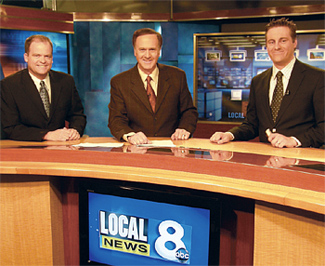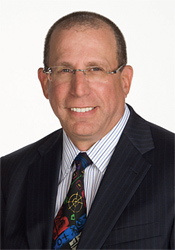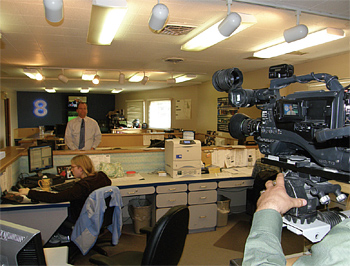Learning From the Veterans

The KIFI news group includes Scott Bemis, sports director Jay Hildebrandt, main anchor and Michael Coats, chief meteorologist.OTTAWA
One year after the DTV transition, the majority of U.S. TV stations are still broadcasting news in standard definition.
Money is the biggest reason for hanging back. When budgets are tight, the last thing station managers want is to purchase new HD camcorders, editors and graphics systems. Yet local news is a key source of ad dollars for TV broadcasters: One way to lose viewers is to be the last newscast in your market to go HD.
For expert advice on how best to make the switch, TV Technology has contacted stations who made the HD leap sometime ago. These stations are “HD veterans,” and they know what pitfalls await HD news rookies.
WATCH THE ASPECT RATIOS!
NTSC/SD has a 4:3 aspect ratio; one based on the dimensions of 1930’s movie screens. HD’s 16:9 aspect ratio brings with it a lot more horizontal real estate than SD.
Unfortunately, a lot of U.S. TV viewers are still using 4:3 NTSC televisions at home. For HD newscasts to keep them and HDTV viewers happy, careful at-tention to aspect ratios is vital. The rule of thumb is this: Anything that is visually vital must be viewable within the 4:3 ratio image. Anything non-essential can dwell safely in 16:9’s left and right “wings.”

Steve Schwaid Meredith-owned CBS affiliate WGCL-TV, (Channel 46) in Atlanta, launched its HD newscasts on Jan. 12, 2009. The newscast took a simple yet effective approach to dealing with aspect ratios: “We marked a map on the studio floor for our weather people, so they know where they can stand and still remain inside the 4:3 shot,” said Steve Schwaid, WGCL’s director of news and digital content. “We are also very careful that our critical weather graphics are within the 4:3 view, including tornado warnings.”
Aspect ratio also matters at WRGB-TV (channel 6) in Albany, NY, owned by Freedom Communications. Its CBS 6 newscasts upgraded to HD/16:9 on Jan. 13, 2008, using Panasonic AK-HC1500G HD box cameras and Sony HD robotic BRC-H700 cameras. Field footage is shot in 16:9 SD using Ikegami HL-DV7W cameras. The editing system is Harris’ Velocity ESX, which deals very well with aspect ratio.
“Our biggest problem with aspect ratio occurs when we receive video from CBS or CNN,” said Fred Lass, WRGB’s director of engineering. “If we aren’t careful in determining whether it originated in SD or HD and we make the wrong conversion decision, the people on screen can end up looking very fat, or very skinny.”
FUZZY NOT ALLOWED
In the old NTSC days, it was possible for newscasts to use “soft,” slightly out-of-focus video; especially on wide angle shots. The resolution of NTSC video was so low, that viewers didn’t notice the “soft” shots.
That’s not the case with HD, according to Mark Danielson, general manager of the KIFI News Group, which operates KIFI-TV (channel 8) in Idaho Falls, Idaho. KIFI’s local newscast made the move to HD on March 1, 2009.
“HD is not a forgiving format, due to its high resolution,” Danielson tells TV Technology. “If a shot is soft or poorly composed, it really shows up on air. This is why our shooters take extra care these days to check their focus, lighting and white balance before turning on their Sony XDCAMs. The good news is that our ENG video looks better than ever before.”

In the KIFI newsroom, Sports Director Scott Bemis prepares for a newsroom hit for the News @ 5pm.16:9 SD ENG
WISC-TV (channel 50) of Madison, Wisc. has been broadcasting HD newscasts since Oct. 28, 2008, shooting studio video on Sony HDC-1500 HD cam-eras. But WISC’s ENG content is shot in widescreen (16:9) SD on Sony XDCAM PDW-510s and PDW-520 camcorders, and edited using Avid Newscutters in SD mode.
“Our set was ready for widescreen years ago, which is why we were able to go in-studio HD in 2008,” said Kevin Ruppert, WISC’s engineering mainte-nance supervisor. “But the cost of converting our SD ENG and editing facilities was prohibitive, which is why we opted to use widescreen SD instead.”
WGCL-TV Atlanta is also shooting in widescreen 16:9, using Panasonic AG-HVX200 P2 camcorders. “It’s a much better viewing experience for the audi-ence,” said Schwaid. “A trained eye can certainly tell the difference between HD and 16:9 SD, but the average viewer cannot. Eventually, we will upgrade our equipment to full HD. But in the meantime, this mixed approach is keeping our audience and our accountant happy.”

WISC’s master control roomTO TRAIN OR NOT TO TRAIN?
Local television has long been the territory of the “can do” attitude, and the HD switch is no exception. At WRGB, for example, “we gave our staff the HD equipment, offered them some pointers and then sent them out to ‘just do it’,” said Lass. “There was no way that we could afford to take the time or afford the expense to train people formally. We just learned on the job, and after some teething pains, we got it right.”
KIFI-TV used the same approach, but Danielson admits that, “given the choice, it would have been helpful to bring in an experienced HD shooter to hold a 1-2 day workshop for our staff. That would have reduced their learning curve and got us up to speed much quicker.”
As for WGCL–TV in Atlanta? “We spent an enormous amount of time on training before we went to HD, and frankly it paid off,” said Schwaid. “We also did a lot of rehearsals before going to air with HD newscasts. The result was that we looked pretty polished when we made the switch.”
With proper attention to aspect ratios, proper camera work and staff preparation, making the move from SD to HD can be relatively painless. As for the improvement in visual quality? “It’s like going from black and white to color,” Danielson says. “It is well worth the effort to satisfy our audience, and our sponsors.”
The professional video industry's #1 source for news, trends and product and tech information. Sign up below.
James Careless is an award-winning journalist who has written for TV Technology since the 1990s. He has covered HDTV from the days of the six competing HDTV formats that led to the 1993 Grand Alliance, and onwards through ATSC 3.0 and OTT. He also writes for Radio World, along with other publications in aerospace, defense, public safety, streaming media, plus the amusement park industry for something different.

